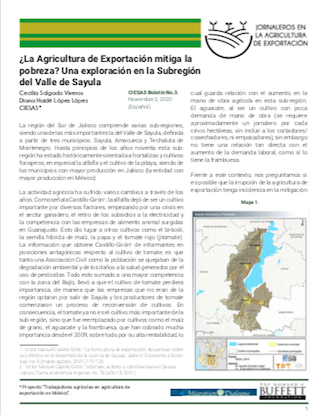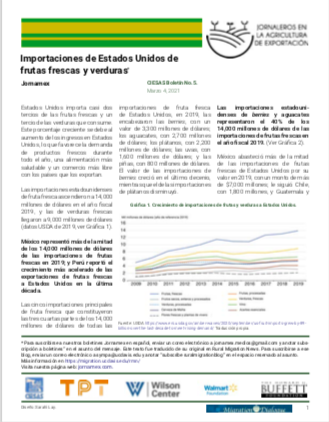
México & Estados Unidos
 |
B01: Women and Men in Farm Work in Mexico: Trends and Gaps, 2005 - 2019 Agustín Escobar Latapí / CIESAS Occidente |
Mexico’s total employment in agriculture, including crops and animals, forestry, hunting, fishing and mining and all employers, employees, self-employed and unpaid labor, fell from 71.4% of the Mexican labor force in 1921 to 58.3% in 1950, 25.8% in 1980 and 13.4% in 2010. Over the past several decades, the farm employment share has continued to decline, but the waged farm workforce has increased in part due to the growth of farm exports.
Leer más...Ciudad Guzmán
 |
B02 English: Export Agriculture and Poverty in the Valley of Ciudad Guzmán Agustín Escobar Latapí, Elisa Alejandra Martínez Rubio, Michelle Judd de la Luz / CIESAS Occidente Project “Farmworkers in Mexico’s Export Agriculture” |
During the eighties and nineties, the economy of Southern Jalisco did not change substantially, and its towns and villages stagnated in economic terms. People left for the U.S. and elsewhere, and both male and female labor force participation and employment rates were low. There were very few internal migrants, signaling that the region did not offer significant job opportunities, and there was widespread deforestation.
Leer más... |
B02 Español: Agricultura de exportación y pobreza en el Valle de Ciudad Guzmán Agustín Escobar Latapí, Elisa Alejandra Martínez Rubio, Michelle Judd de la Luz / CIESAS Occidente Proyecto “Trabajadores agrícolas en agricultura de exportación en México” |
La agricultura del sur de Jalisco se ha destinado a mercados nacionales e internacionales desde hace por lo menos 140 años. A diferencia de otras economías locales, como la del Valle de Culiacán, el desarrollo regional del sur de Jalisco se centralizó desde la década de 1940. Es decir que los empresarios líderes de la zona nunca alcanzaron el grado de influencia que ejercieron sus contrapartes en Culiacán.
Leer más...Sayula
 |
B03 English: Does Export Agriculture Reduce Poverty? An Exploration of the Sayula Valley Subregion |
The southern part of the state of Jalisco includes various subregions, one of the most important of which, the Sayula Valley, consists of three municipalities: Sayula, Amacueca, and Techaluta de Montenegro. Until the early 1990s, this subregion focused on the cultivation of fruits, vegetables, and feed crops, especially pitaya (dragon fruit) and alfalfa. These municipalities have one of the highest production rates in Jalisco, the state with the highest production nationally.
Leer más... |
B03 Español: ¿La Agricultura de Exportación mitiga la pobreza? Una exploración en la Subregión del Valle de Sayula Cecilia Salgado Viveros / Diana Haidé López López / CIESAS Occidente |
La región del Sur de Jalisco comprende varias sub-regiones, siendo una de las más importantes la del Valle de Sayula, definida a partir de tres municipios: Sayula, Amacueca y Techaluta de Montenegro. Hasta principios de los años noventa esta subregión ha estado históricamente orientada a hortalizas y cultivos forrajeros, en especial la alfalfa y el cultivo de la pitaya, siendo de los municipios con mayor producción en Jalisco (la entidad con mayor producción en México).
Leer más...San Quintín
 |
Resumen Ejecutivo del Estudio Regional de San Quintín. Crecimiento agrícola y condiciones de trabajo en el Valle de San Quintín. Agustín Escobar Latapí / Elisa Alejandra Martínez Rubio / Diana Haidé López López / CIESAS Occidente |
Resumen Ejecutivo
Este estudio regional proporciona una evaluación de las condiciones de vida de los trabajadores agrícolas en Baja California, México, como resultado del análisis de bases de datos oficiales, de nuestra propia encuesta de trabajadores y del trabajo de campo realizado en el área de estudio. El estudio se centra en San Quintín, área que forma parte de la “Región Costa” de Baja California. Este estudio regional da cuenta de las condiciones actuales como resultado de los procesos sociales de cambio regional que se han presentado desde hace cinco décadas, los cuales han sido desencadenados, entre diversos factores, por la construcción de la carretera transpeninsular y el desarrollo de una economía centrada en la agricultura de exportación.
Leer más... |
Summary. Regional Study. Industrial Agriculture and Working and Living Conditions in San Quintín, Baja California, Mexico Agustín Escobar Latapí / Elisa Alejandra Martínez Rubio / Diana Haidé López López / CIESAS Occidente |
Summary
This regional study provides an assessment of living and working conditions for farm workers in Baja California, Mexico, resulting from official database analyses, our own worker survey and direct fieldwork. The study focuses on San Quintín, recently known as the “Coastal Region” of Baja California. The regional study explains current conditions as an outcome of social processes taking place over five decades of regional change triggered, among other factors, by the completion of the Transpeninsular Highway and the development of an agricultural export economy.
Leer más...Sinaloa
 |
B04 Español: Pobreza y trabajo agrícola en el Valle de Culiacán Elisa Alejandra Martínez Rubio / Michelle Judd de la Luz / CIESAS Occidente |
El Valle de Culiacán, ubicado en la parte central del estado de Sinaloa, es una de las zonas de producción agrícola más importantes del país. Su relevancia en la agricultura comercial y de exportación se remonta a finales del siglo XIX. Desde entonces, en esta región se ha cultivado el maíz grano, la caña de azúcar, el tomate rojo (jitomate) y la berenjena.
Leer más... |
B04: Poverty and Agricultural Labor in the Culiacaフ] Valley 2010-2020 (Updated version from 2010 to 2020) |
This bulletin assesses the change in poverty levels in the main two municipalities from 2010 to 2020.
- Agricultural output and agricultural exports from Sinaloa, consisting of tomatoes and many other crops, continued to increase from 2010 to 2020.
- During this period, multidimensional poverty fell substantially in the large city of Culiacán, but it worsened in its most intensely agricultural neighbor, Navolato.
- We believe many of the benefits of export agriculture are finding their way to Culiacán. The economic dynamics of export agriculture benefit Mexico's middle sized cities in export areas.
- However, we also believe that the informal "pay and go" system under which many work in Navolato has played a role in keeping poverty there at relatively higher levels.
Bajío
México y Estados Unidos
 |
B05: Importaciones de Estados Unidos de frutas frescas y verduras |
Estados Unidos importa casi dos tercios de las frutas frescas y un tercio de las verduras que consume. Este porcentaje creciente se debe al aumento de los ingresos en Estados Unidos, lo que favorece la demanda de productos frescos durante todo el año, una alimentación saludable y un comercio más libre con los países que los exportan.
Leer más... |
B06 Español: La agricultura de exportación y la pobreza de sus trabajadores. Agustín Escobar Latapí / CIESAS Occidente |
¿Qué significan los salarios que se pagan en la agricultura mexicana? ¿Alcanzan para comprar los bienes y servicios básicos o no? ¿Son “salarios de pobreza” o “salarios dignos”? Definir si estos salarios son o no suficientes para ubicar a los hogares de los trabajadores agrícolas por arriba o por debajo de la línea de pobreza es fundamental tanto por razones éticas, es decir si las empresas pagan o no salarios suficientes, como por razones políticas.
 |
B06 English: Mexican Export Agriculture and the Poverty of Its Workers Agustín Escobar Latapí / CIESAS Occidente |
What kind of wages are there in Mexican agriculture? Are they sufficient to purchase basic goods and services? Are they “poverty wages” or “fair wages”? Determining whether these wages are sufficient to locate workers’ households above the poverty line is fundamental for ethical reasons—to determine whether companies are providing adequate compensation—as well as for political ones: for the first time, the U.S.-Mexico-Canada trade agreement (USMC) now includes labor clauses that can quickly shut off a company’s exports (the rapid response mechanism, or RRM). It is true that other labor issues are central to the USMC—the freedom to organize in trade unions and to democratically elect union leaders— but for the first time, wages are also part of the treaty. In this text we provide an example of this measure for workers in export agriculture.
 |
Boletín temático: El servicio de guarderías para trabajadores agrícolas en 2021. |
Uno de los cinco seguros incluidos en las cuotas del Instituto Mexicano del Seguro Social (IMSS) es el de las guarderías. Hasta hace un año, solo las madres podían solicitar el servicio de guardería, pero ahora ya los padres trabajadores también tienen derecho de que sus hijos accedan a él.
 |
Bulletin: Childcare Services for Agricultural Workers in 2021 Agustín Escobar Latapí / Mercedes González de la Rocha / CIESAS Occidente |
One of the five services covered by the fees collected by Mexico’s Social Security Institute (IMSS) corresponds to childcare centers. Until 2020, only mothers could apply for this service, but now working fathers also have a right to place their children there.
 |
Boletín temático: Nueva edad mínima para el trabajo agrícola en México Elisa Alejandra Martínez Rubio / Diana Haidé López López / Sarahí Lay Trigo / CIESAS Occidente |
Hasta hace unos años, el trabajo de niñas, niños y era una constante en el campo mexicano. La participación de los menores de edad a través del trabajo familiar ha sido parte fundamental de las economías campesinas. Sin embargo, fuera de la economía familiar, la mano de obra infantil también ha sido empleada, en condiciones sumamente precarias.
Leer más... |
Bulletin: The New Minimum Working Age for Agricultural Labor in Mexico Elisa Alejandra Martínez Rubio / Diana Haidé López López / Sarahí Lay Trigo CIESAS Occidente |
Abstract
Mexico in 2015 barred persons under 18 from working for wages in agriculture. One result was only workers 18 or older on export farms, but not on farms that produce for the domestic market. A reform approved in 2022 allows workers who are 15 to 17 to work for wages in farm jobs deemed appropriate by the Ministry of Labor. Allowing some of the 2.6 million 15 to 17 year olds in counties with fewer than 15,000 residents to work for wages in agriculture can enable youth to earn wages and reduce labor shortages, but could also reduce school attendance: 73 percent of 15 year olds were in school in 2020 in counties with fewer than 15,000 residents, 65 percent of 16 year olds, and 59 percent of 17 year olds. Additionally, teenage girls are often the main caregivers in poor rural households, since most child care centers and full-time schools have been closed. If these teens start full time work, the social protection system for smaller children must be strengthened.
Leer más... |
Trabajadores en la Agricultura de Exportación de México: De la Investigación a la Acción Acuerdos y Recomendaciones Grupo de Trabajo del Centro Wilson sobre Trabajadores Agrícolas Mexicanos en la Agricultura de América del Norte |
 |
Workers in Mexico Export Agriculture: From Research to Action Agreements and Recommendations Wilson Center Task Force on Mexican Farm Workers in North America’s Agriculture |
